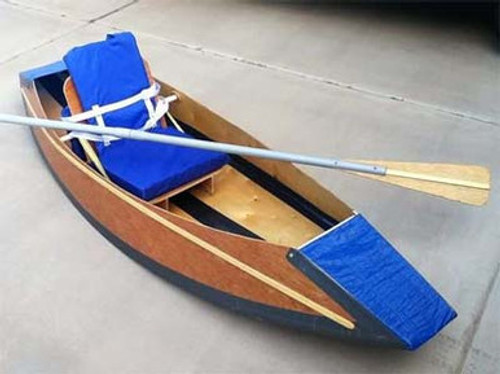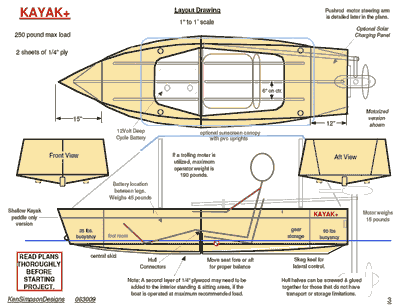
KAYAK specifications:
- OAL: 95 inches
- Max Width: 30 inches
- Height: 15 inches (12" option)
- Weight: 40 pounds
- Max load = 250 pounds
- Draw: 4", with average weight operator
Well, I have completed yet another boat design/build. This took me exactly 3 weeks to build and get in the water. I do know that you too are building a new boat, using high tech materials, for the upcoming Lake Powell Messabout. Can't wait to see it.
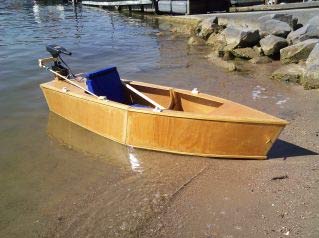
My new boat is called "KAYAK+". An 8 foot long, single occupant, 40 pound, 2 piece design using a trolling motor or dual paddle for propulsion. As usual, no trailer required. I have kept this boat as simple to build as possible, and have eliminated fancy curves in favor of easier to produce straight lines wherever allowed.
Yes, it uses the Tape & Glue construction. For test purposes I used only one layer of glass cloth for all the seams. We'll see how this works out. The hull design is a little different than most, as the chine at the center of the boat is wider than the gunwale. This provides an angular side that is narrow at top, making paddling very easy. There are 2 versions of the design: motorized, with 12 inch side panels (as shown), and paddle-only, with 9 inch side panels. The paddle-only version is more Kayak looking, low and sleek, but otherwise all other dimensions are identical, and both are displacement hulls. In fact, the chine is straight from bow to stern.
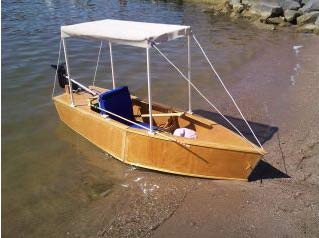
KAYAK+ was fun to build, and if today's maiden voyage was any indicator, it will be fun on the water too. I spent about 3 hours testing all aspects of the design. For a small boat it is quite stable, due to the wide base I suspect. It registered 4.2 mph on the Duckworks GPS at full speed. Not bad. I was told by those watching that it sits evenly in the water. Under power the motor, a 36 pound thrust electric, tended to lift the stern slightly at full speed. This was caused by the motor not sitting perpendicular to the water. I have already corrected this with a wood shim on the transom motor mount that realigns the motor shaft to vertical. Another item that needs addressing is the steering rod. I had to hold on to it at all times, otherwise the motor would tend to drift to one side or the other, causing the boat to turn unnecessarily. I will devise a temporary locking mechanism to hold the steering rod in position, until pressure is applied to turn. Other than these two items, everything went smoothly. Breaking through the wake of large power boats proved to be no problem. The pointed bow develops a small wake which disperses by the time it reaches the stern of the boat. The stern developed no discernable wake itself, proving the hull shape to be almost ideal for such a small craft.
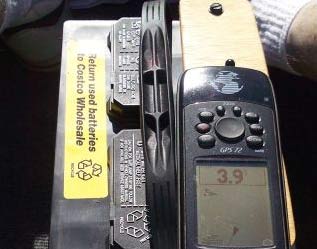
Some finishing touches remain to be completed. I will paint a red stripe around the gunwale area, and place a removable canvas cover over the foredeck to block the sun and any water spray that may occur. Already I have outdoor carpeting in the forward standing area, and may do the same in the aft section for appearance only. Overall I am very pleased with the way the boat performs, looks and feels on the water.
I think KAYAK+ will be a popular design, as the basic hull build cost is only around $110, with the completed boat less than $175. Of course this does not include the motor, and battery for the electric version. In conclusion, the plans are 28 pages with plenty of descriptive photos, including some of the boat in the water.
KEN SIMPSON
David Balmer of Canada is building the Kayak+, and it's now complete.
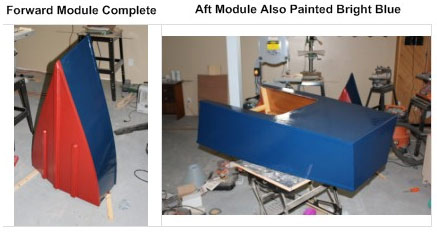
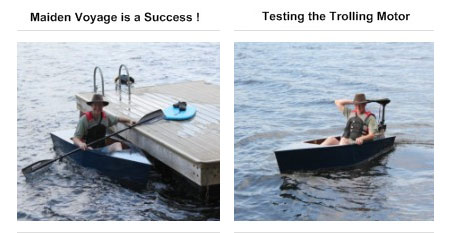
He said it went great, and no leaks. Now it's time to add the finishing touches, like remote steering and carpeting.
The completed boat with pictures and video. David did a great job of building and finishing, and should be proud of his accomplishment.





